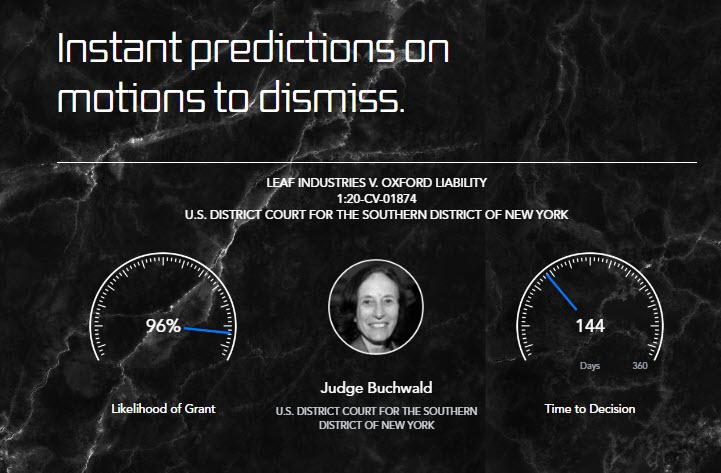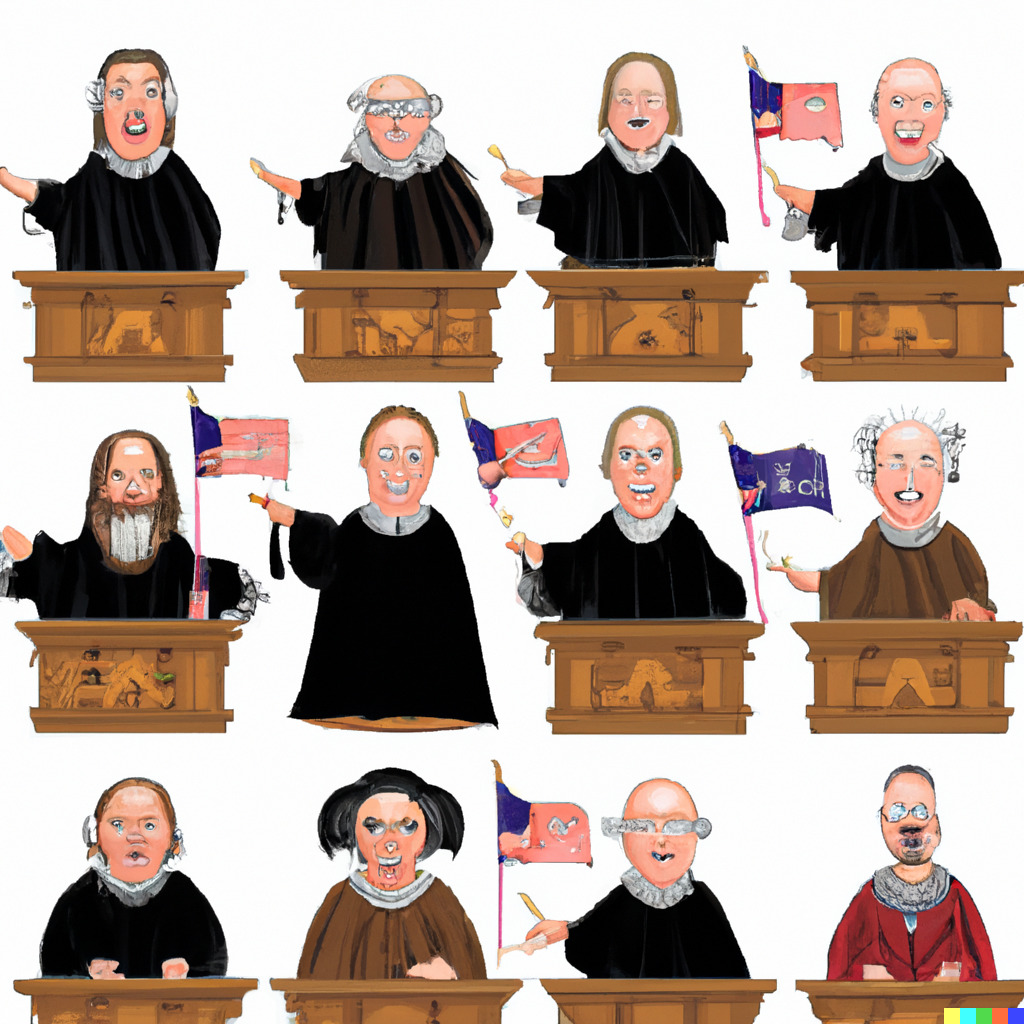
The trifecta of big data, advanced analytics, and recent AI innovations is ushering in a new era of judicial analytic mind-reading, enabling software to more accurately predict judges’ court rulings. Last year, in what seems like an interesting leap forward in judicial analytics, Pre/Dicta unveiled its AI-powered litigation prediction software, introducing a novel, perhaps radical, approach to tapping into the judicial mind. According to CEO Dan Rabinowitz, Pre/Dicta is the only litigation analytics platform that makes verifiable predictions about the outcome of lawsuits. He claims that using data science and only a docket number, Pre/Dicta’s software correctly forecasts how judges will decide on motions to dismiss 86% of the time, without factoring in the specific facts of the case. The system covers civil litigation cases at both the state and federal level, but does not attempt to forecast results of jury trials.
Rather than solely depending on a judge’s past rulings and jurisprudence, as is common with other judicial analytics products, Pre/Dicta uses a methodology similar to that used in targeted advertising. This approach forecasts future behavior by examining both past actions, such as purchasing habits, and individual biographical characteristics. Pre/Dicta works by combining historical ruling data with biographical and demographic details to forecast a judge’s decision in a given case. Using around 120 data points, it spots patterns and potential biases in a judge’s past rulings. The system evaluates specifics of past rulings, considering elements such as the nature of the case (e.g., securities fraud, employment discrimination), the attorneys and firms involved (e.g., solo practitioner representing an individual, regional firm representing a corporation, AmLaw 100 firm backing an individual), and the nature of the disputing parties (e.g., individual vs. corporation, small company vs. large corporation). This case-specific information is then combined with the judge’s personal data, like net worth, political affiliations, professional history, and law school alma mater, to generate a prediction.

Prediction in the Legal Landscape
86% accuracy is impressive! Hopefully, Pre/Dicta will spark a judicial prediction analytics arms race. According to Daniel L. Chen in his article, “Judicial Analytics and the Great Transformation of American Law,” predictive judicial analytics “holds the promise of increasing the efficiency and fairness of law.” Targeted advertising seems to work pretty well, so hopefully Pre/Dicta’s advancements in this area is a positive step toward making the judicial process more transparent.
If only we knew what would happen in the future, we would know what to do now! For as long as there have been courts and judges, folks have tried to predict whether a judge would rule in their favor. Attorneys have always engaged in mental “judicial analytics” by gathering and pondering information on a judge’s past rulings and reputation to glean some insights into how they might decide a case. Humans are prediction machines, given our innate tendency to draw on experiences and knowledge to anticipate events—an evolutionarily useful skill that allowed us to sometimes escape being saber-toothed tiger lunch or the victim of grumpy neighboring tribal predations.

From my brief stint practicing family law in the 1990s, I discovered that family law clients are hopeful individuals. Despite clear child support guidelines and a prevailing judicial preference for shared custody, people often believed that if a judge merely heard the specifics of their “special snowflake” scenario involvinga cheating spouse or a deadbeat dad, the judge would surely deviate from the rules and customary practices to grant them a deserved favorable ruling. They struggled to accept that judges could be indifferent to their parade of marital/parental horribles. And even if judges were initially inclined to empathize, after many years of sifting through outright lies and half-truths, they had seemingly given up on given up on deciphering reality anyway. It was always challenging to persuade clients of the judicial propensity to metaphorically split the baby down the middle, whether financially or custodially.
Attorneys have needed to hone their abilities to predict outcomes so they could counsel their clients on different courses of action. While making no promises, they share predictions regarding claim values, the odds of surviving summary judgment, potential jail sentences, the likelihood of obtaining sole custody of children, and so on. Attorneys can only do so much, though. Hopefully, as predictive judicial analytics tools improve and become widely available, they have the potential to promote fairness, cut down on litigation costs, and create a more transparent and predictable judicial system.
Judicial Behavioral Forecasting Modeling

Certainly, judges do provide clients with information that assists in anticipating how a ruling might unfold. I have observed numerous judges delivering impactful speeches during temporary hearings, highlighting the importance of adhering to child support guidelines and the principle of shared custody. When clients receive information regarding a likely outcome, their acceptance of reality accelerates significantly. It would indeed be beneficial, and save a lot of time, money, and anguish, if a client could engage in a comprehensive discussion with a judge, probing various questions about how different pieces of information might influence their ruling. However, this isn’t the modus operandi of judges, as they cannot communicate with one party in a suit independently, nor do they pre-announce their rulings prior to a hearing or trial. Now, however, companies like Pre/Dicta are leveraging the human trait of predictability inherent in judges. Like everyone, judges have their own set of ideas, habits, preferences, prejudices, and temperaments shaped by a mix of genetics and experiences, all of which contribute to a certain level of predictability in their rulings.
Hopefully, soon we will be able to pick the mind of a judge without the necessity of actually speaking with her. With the advancing tide of artificial intelligence and the ongoing proliferation and refinement of judicial analytics products, it seems plausible that the future might produce a family law judge behavioral forecasting model for specific judges. These models could help attorneys and their clients identify potential biases of judges. They could see how a judge might respond to a person based on certain characteristics like sex, race, age, income, profession, or criminal history, especially when compared to another party with a different background. Also, if these models included information about factors that affected past rulings, they could be used to anticipate how certain situations might be viewed by the court. For example, a parent hoping to keep their soon-to-be ex-spouse away from the kids might want to know if the judge objects to stuff like dating app addiction, not taking the child to piano lessons, or multiple DUIs arrests. Armed with information, they can choose the best way to handle their case, including deciding if going to trial is a good idea.
Behavioral forecasting models are of course not new to law and legal practice. They are tools used to predict the likely behaviors of individuals or groups across various domains, aiding in better decision-making. In the legal sector, in addition to predicting the outcome of Supreme Court cases, they aid in litigation strategy, legal analytics, resource allocation, criminal behavior prediction, policy impact analysis, legal document analysis, dispute resolution, and regulatory compliance, by leveraging historical data and legal precedents to inform decision-making and strategy development. They are utilized in other fields too like marketing, finance, HR, healthcare, public policy, urban planning, criminal justice, technology, environmental science, and education to forecast behavioral patterns, helping to optimize strategies and allocate resources more efficiently.
Such an innovation would undeniably be a game changer. Clients in divorce and custody disputes might believe solid advice regarding likely outcomes, rather than cling to the hope that their unique case details will influence the judge. Accurate predictions would likely deter individuals from wasting money, and likely be a boon for judges struggling with a backlog of cases. Having these predictive tools on their websites would no doubt promote case settlements and therefore ease some of the strain on both judges and the judicial system.
Naysayers

As always, naysayers abound. Some argue that judicial analytics could undermine the legitimacy of an impartial judiciary. In fact, in France, judges are so wary of transparency that judicial analytics products are prohibited. Well, at least in the U.S., that boat has sailed, far and fast. Particularly in light of Supreme Court rulings in recent years, many people have realized that judges often base their rulings on ideological leanings and personal preferences. Robots would only further confirm what we already suspect – that judges are just like the rest of us with habits, biases, and opinions. It might be too late to rehabilitate the judiciary, but perhaps the transparency of data-driven prediction could bolster public confidence more than frequent affirmations of judicial objectivity.
Then, there are arguments regarding fairness due to cost. For now, the high cost of Pre/Dicta raises potential fairness issues, as only larger firms and wealthier clients can harness its predictive power. True, they always have an advantage. However, as the technology becomes more common, costs should decrease, making it more and more accessible.
Conclusion
The improvement of AI-driven judicial analytics, exemplified by Pre/Dicta, could mark a revolutionary shift in the legal realm, perhaps promising a new level of predictability and transparency in court outcomes. While concerns about fairness, accessibility, and the perception of judicial impartiality persist, the potential benefits—reduced litigation costs, enhanced transparency, and more informed decision-making—may herald a future where data-driven insights guide legal strategy and expectations. As technology continues to evolve and become more accessible, the future looks promising for both practitioners and those seeking justice.
